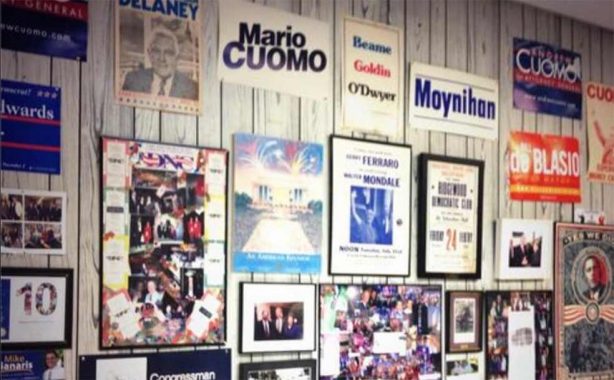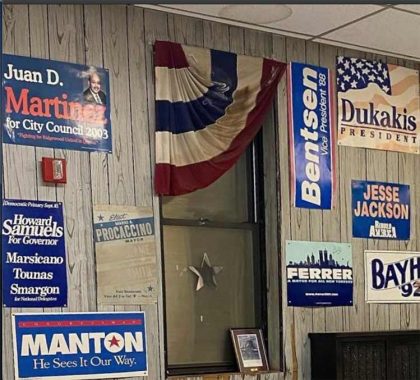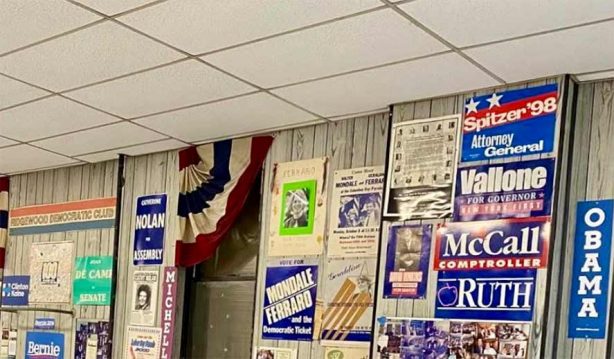
Last week I posted an item about Stier Place in Ridgewood, whose highlight is the 1916 Ridgewood Democratic Club. Sergey mentioned he has some photos from the interior…

INSIDE the Ridgewood Democratic Club, the walls feel like a museum of campaign graphic design, with posters for candidates who have won and lost over the past century. Longtime Democratic activist Tammy Osherov shared a photo of the wall featuring the poster for John F. Kennedy, the youngest person elected president.
The handsome Bostonian’s poster shares the wall with his younger bother Ted, who unsuccessfully challenged incumbent Jimmy Carter in the 1980 primary. Above JFK is the first Roman Catholic who ran for president on the Democratic ticket, Governor Al Smith in 1928. He was raised on the Lower East Side and buried in Queens. Grace Meng who won her congressional seat in 2013, representing northeast and central Queens; Nydia Velazquez is a former Councilwoman who won her Brooklyn seat in 1993. Her district extends for a few blocks into Queens.

Forgive the blurry quality here, but this wall is filled with important names that made history such as 1984 Vice Presidential finalist Geraldine Ferraro, first Black president Barack Obama, and New York legends Mario Cuomo and Daniel Patrick Moynihan. Former mayors Abe Beame and Bill de Blasio also appear here.

Son of Greek immigrants Michael Dukakis ran in 1988, defeating Rev. Jesse Jackson in the primary, and then losing to the senior George Bush in the general election. His running mate was Lloyd Bentsen, who later served as Treasury Secretary under Bill Clinton. The Bayh here is Birch Bayh, an Indiana senator who lost the 1976 primary to Jimmy Carter. Tom Manton was the longtime Congressman from Woodside who also served as chair of the Queens County Democratic Organization. He was fiercely protective of incumbents, knocking challengers off the ballot by disputing their petitions. Finally, Fernando Ferrer was the Bronx Borough President who ran for mayor three times, losing to Rudy Giuliani and then Michael Bloomberg.

Atop this wall is the 1998 poster Eliot Spitzer running for Attorney General. Having earned his reputation as the “sheriff of Wall Street,” he later advanced to governor with the largest margin to date. But then he fell from grace because of a prostitution scandal. In 2025, he became the honorary chair of the architecture school at CCNY that carries the names of his philanthropic parents. The rest of this wall did much better in their domestic affairs. They include Manhattan Borough President Ruth Messinger who ran for mayor in 1997, losing to Giuliani. She later became president of a humanitarian nonprofit. City Council Speaker Peter Vallone ran for governor in 1998, losing to George Pataki. He later founded a political consulting firm. State Comptroller Carl McCall, also tried to unseat Pataki in 2002. He later chaired the SUNY Board of Trustees. Next to McCall and Ruth is David Dinkins, who served one term as mayor in the 1990s. He later taught at his alma mater, Columbia University and sat on the boards of various nonprofits.
Sergey Kadinsky is the author of Hidden Waters of New York City: A History and Guide to 101 Forgotten Lakes, Ponds, Creeks, and Streams in the Five Boroughs (2016, Countryman Press), adjunct history professor at Touro University and the webmaster of Hidden Waters Blog.
Check out the ForgottenBook, take a look at the gift shop. As always, “comment…as you see fit.” I earn a small payment when you click on any ad on the site.
6/15/25


4 comments
Political clubs also used to be social clubs with outings,picnics,dances,etc.
My grandmother went to dances at Tammany Hall in the 1920s.
In an era earlier than the one Chris is referring to, namely, the “Gangs of NY” era, Tammany Hall and its equivalents, strongly-built young men would come around and sell tickets to such events, which were called “rackets” on account of the raucousness they produced. They would say, “[Ward Heeler] is counting on your being there, if you catch my drift…” and would cow the local merchants into buying the tix even if the merchants had no intention of showing up (they’d usually give away the tix). These young men were referred to as “racketeers,” which is supposedly how the term came into being describing coercive activities by criminals.
David Dinkins taught at Columbia, but it was not his alma mater.
He graduated from Howard University and Brooklyn Law School.
Thank you. I’ll ask Kevin to make the correction. Mr. Dinkins was very closely associated with Columbia after his mayoral term ended.
Also seen on this wall, a poster for Mario Procaccino, who won the race for Comptroller in 1965 and lost for mayor in 1969.
His name sounds like something you’d see on a menu.